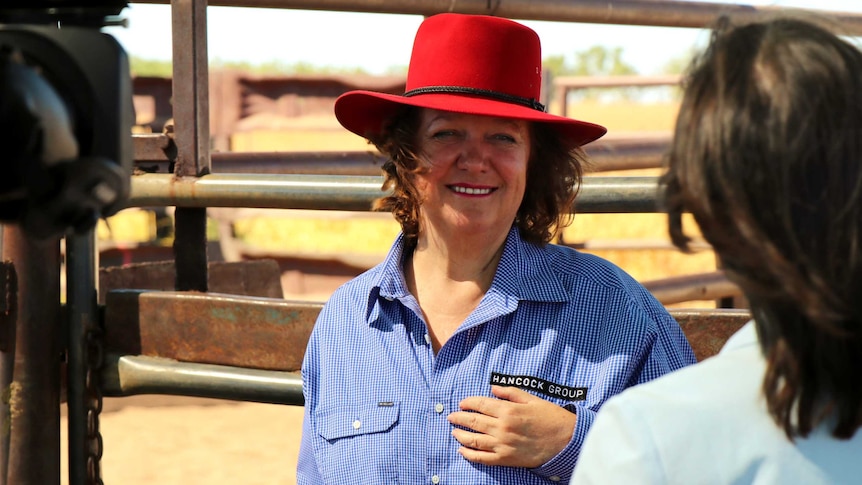In the heart of Western Australia’s Pilbara region lies sacred country, littered with lucrative iron ore mines that provide billions for Australia’s economy.
Now, the WA government wants to invest in roads near Karijini National Park and Wittenoom so Gina Rinehart’s Hancock Prospecting can transport iron ore through the region.
Fears for Aboriginal heritage have been sparked by the proposal, and also questioned due to its proximity to the deadly asbestos at Wittenoom — the largest contamination site in the Southern Hemisphere.
Documents seen by the ABC reveal the proposal has not been costed but includes more than 300 kilometers of upgrades and multiple new bridges on Nanuturra Munjina Road, Hamersley Mount Bruce Road, and Karijini Drive.
Aaron Rayner manages cultural heritage for Wintawari Guruma Aboriginal Corporation (WGAC), which holds native title for the area.
He said more than 40 significant sites would be damaged by the road project in the Hamersley Range, especially in an area called Rio Tinto Gorge.
The project would require land clearing and camps for up to 200 workers.
“The proposal is to essentially develop a haul road that runs across and right through Eastern Guruma country and will interfere with very important Aboriginal heritage,” Mr Rayner said.
“There are about 45 Aboriginal sites that would be impacted, but there are many unknown and unrecorded Aboriginal heritage sites that will be impacted.”
The upgrades would allow trucks carrying iron ore from Hancock’s Hardey operation to access the Great Northern Highway on the eastern edge of Karijini.
The mining company launched a feasibility study this year on the Hardey project in partnership with its owners Australian Premium Iron, with Hancock to lead any future development.
Government approached after Hancock rejected
Mr Rayner said Hancock approached WGAC for heritage consultation earlier this year, but they rejected it.
He said traditional owners then received a proposal from Main Roads WA, which backed Hancock’s plan.
Traditional owners have since written to Transport Minister Rita Saffioti and Hancock to voice their concerns.
“Eastern Guruma elders advised Hancock Prospecting that they were opposed to the construction of the road,” Mr Rayner said.
“We hope that both Hancock Prospecting and the Minister for Transport have listened to the Eastern Guruma elders and decided not to build the road.”
A Hancock spokesperson said the company consulted with all stakeholders about its operations and had engaged with traditional owners.
“Any option under consideration by Hancock is done so in consultation with Main Roads WA, in addition to traditional owners, to ensure heritage and cultural social values are understood and respected,” the spokesperson said.
The documents seen by the ABC show Main Roads WA, which owns the roads in question, contacted traditional owners about the proposal after Hancock pitched the idea.
“Main Roads now has the opportunity after being approached by Hancock Prospecting,” the documents state.
The project would start in 2023 and take about three years to complete, according to the documents.
A spokesperson for Ms Saffioti claimed no direct contact had been made with the minister but said Main Roads WA would engage with stakeholders including traditional owner groups.
Deadly asbestos risk for road workers
The proposal also includes a realignment of Nanuturra Munjina Road around Wittenoom, the site of disastrous asbestos mining historically led by Gina Rinehart’s father, Lang Hancock.
Mountains of deadly blue asbestos tailings litter the area around the town known as the Wittenoom Asbestos Management Area.
The WA government officially closed Wittenoom in March as it considered the asbestos to be a public health risk with plans to demolish the town’s few remaining properties.
Curtin University respiratory health professor Fraser Brims said workers on the project in and around Wittenoom would be risking lung cancer and other deadly asbestos-related diseases.
“We don’t know with asbestos if there is a safe exposure level, so really if exposure can be avoided then it must be avoided to keep workers and indeed anybody safe,” Professor Brims said.
Professor Brims said extensive protective equipment would be required, which would be difficult to enforce in the intense Pilbara heat.
“Gold standard protection would be a full PPE suit. It’s heavy equipment, it would be very uncomfortable in the heat,” he said.
“Workers, because of the heat, would become uncomfortable. In time the concern would be they’d look to cut corners.”
A Main Roads WA spokesperson said the project was in its early planning stages, but any asbestos risk would be managed and traditional owner groups had been engaged.
.
